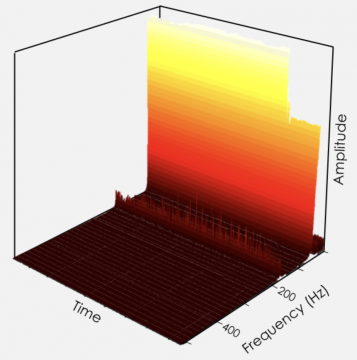Vibration Sensing Based on RVmagnetics’ MicroWire Technology
General Overview of Vibrations
Vibrations represent mechanical oscillations around an equilibrium position. Vibrations are characterised by the amplitude, frequency, resonant frequency, and other physical quantities. The characterisation of vibrations can be in some industries crucial, as it can serve for predictive maintenance, health monitoring of rotating machinery, optimisation of performance, and more. For this purpose, a lot of commercial, off-the-shelf vibration sensors are already available: Piezoelectric Accelerometers, Micro-Electro-Mechanical Accelerometers (MEMS-Accelerometers), Strain Gauges, or Capacitive Accelerometer. All of the mentioned sensors have their advantages in different industries; however, they meet one disadvantage: they need an electrical contact implemented directly on the vibrating object.
Contactless Approach
RVmagnetics provides a unique vibration sensor based on our patented MicroWire technology. Different approaches might be utilised to obtain data according to the requirements from the client's side. One approach is to place the MicroWire on a vibrating object and sense its vibration in contactless measurement from a distance up to 10 cm. Thanks to the MicroWire’s dimensions no additional space is needed or weight is added on the object.
Another approach already approved in a real environment (at TRL 8 level) is a complex vibration sensor with the MicroWire and data acquisition device (sensing head) integrated into one compact solution. Such a sensor, depicted in Figure 1, was designed to detect vibrations only in one direction. Employing 3 sensors placed orthogonally allows us to determine vibrations in 3 directions separately. The size and shape of the sensor can be adjusted according to the requirements.
Moreover, such a vibration sensor is capable of qualitative temperature measurement and can also serve as an electromagnetic noise detector. This allows us to reveal whether a proximate electromotor is running or the surrounding environment has elevated temperature.
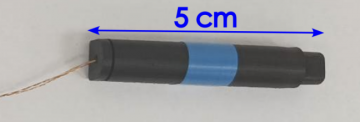
Considering the current electronics construction and technical limits, the RVmagnetics’ vibration sensor capable of detecting vibrations from ones of Hertzs up to 500 Hz. By the change of the electronic settings, the maximal detectable resonant frequency can be enhanced.
Another advantage of the system provided by RVmagnetics is the separability of the sensors and the control unit at a distance of more than 10 metres. It is possible to perform 24/7 data collection altogether with their processing, which serves as preventive and predictive maintenance for the monitored object. It can provide information about the malfunction employing the traffic light approach: green – everything is OK, yellow – some peculiar behaviour was detected for a short time, red – the vibrations behaviour is out of standard operation. Moreover, the data could be sent to the cloud, where they can be saved and processed, decreasing the computational complexity on the side of the industrial computer.
RVmagnetics vibrations sensors were employed to detect 3-dimensional information about the vibrations on a cooling fan of a 2 MW diesel power generator. The fruitful collaboration with the EN-Invest, a.s. proved the reliability of the sensors during several months of non-stop vibration monitoring. Some of the results are concluded below.
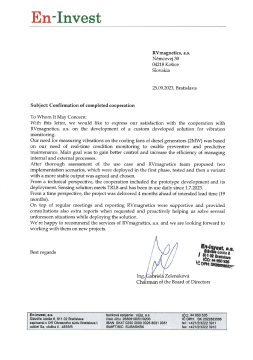
Typical data obtained by RVmagnetics’ vibration sensor, during standard operation of the diesel power generator and its cooling fan, are displayed in the following figure. From the data, clear conclusions can be made about the current state of the power generator. The idle state with the turned-off power generator and fan is represented by background vibrations (1). When the power generator and its fan were turned on, huge oscillations were detected by the sensor (2), followed by the standard vibrations of the system (3). After the generator was turned off, the fan remained turned on to cool the cooling circuit, and the vibrations were suddenly reduced, see point (4). When the final temperature of the cooling circuit was reached, the fan was turned off as well – leading to the gradual damping of the mechanical oscillations (5) back to the background noise.
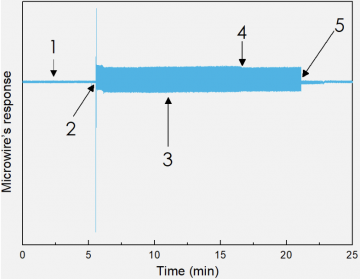
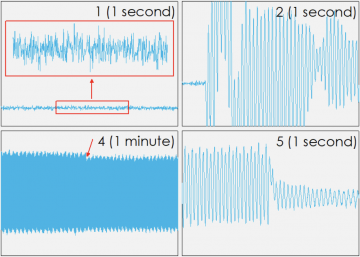
The data obtained by the MicroWire vibration sensor are directly proportional to the amplitude of the mechanical vibrations with a data density of 1000 data points per second. This allows us to perform the Fourier transformation of the obtained signal, and continuously monitor the change of the present frequencies, and their amplitudes in real time, as shown in the following figure. Such monitoring can later point to the peculiar behaviour of the monitored system and provide necessary information to protect the monitored hardware.
